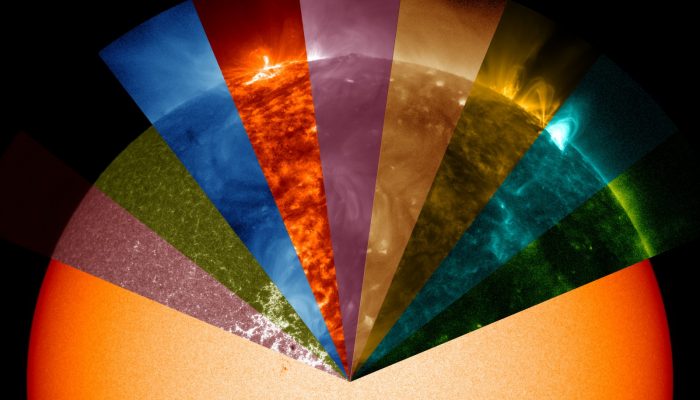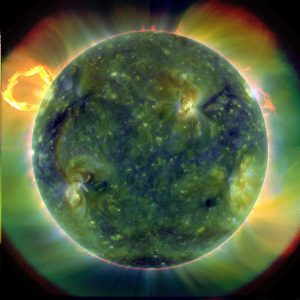
The Sun is a complex, dynamic ball of plasma which influences our lives. Studying the Sun is challenging because each of its layers have different composition, physics and wavelengths of emssion. Moving outwards from the photosphere (visible surface of the Sun), we have the chromosphere and the corona (hottest outermost layer). The solar plasma is in constant motion much like fiercely boiling water. To make matters worse, gigantic planet sized eruptions frequently play havoc with space-based instruments and communications.
To understand the workings of the Sun, solar physicists look through the eyes of 21 ground-based telescopes, 8 space-based observatories, dozens of radio telescopes, X-ray detectors, and many high altitude platforms that collect particles emitted by the sun. Optical astronomy, spectroscopy and magnetic field measurements are the most common techniques used.
The most common ground-based observations are taken with Hydrogen-alpha and Calcium-II filters. The Sun’s chromosphere is abundant in these elements/ions and emits light in these wavelengths. Chromospheric features such as spicules, prominences (i.e., jets, protrusions of plasma respectively) etc. are studied using these observations. The Sun’s hot corona emits light in UV and EUV wavelengths. Since emissions in this range are absorbed by the Earth’s atmosphere, we rely heavily on space-based observatories to study coronal loops, flares etc. The variety of structures on the Sun and the different layers of the Sun are abundant in specific elements/ions. The stunning images from different filters (see fig 1) provide unique ways to probe the depths of our amazing Sun. Simultaneous images from the 9 filters onboard NASA’s Solar Dynamics Observatory has been revealing secrets of our dynamic Sun since 2012.
Optical telescopes are easy to build but only give us the overall view of the Sun. The temperature, ionization state, density, magnetic/electric fields, speed/direction of motion all influence the emission from a particular plasma. We require spectroscopic data to extract this information. Spectral profiles can also give us indication of unresolved structures. The latest spectrograph in the sky is NASA’s Interface Region Imaging Spectrograph. Although spectrographs provide a large dose of information, they are limited by field-of-view and downlink bandwidth. Scientists therefore need to compromise on the number of wavelengths or area of observation when using spectrographs, restricting their progress.

Fig. 2: Composite image showing multi-temperature plasma. Cool 60,000 K plasma in red and hot 1 MK plasma in blue and green Credits: NASA/GSFC/SDO
The Sun’s 22-year magnetic cycle is another mystery pending to be solved. Manifestations of the magnetic field result in solar activity. Unambiguous measurements of the magnetic field are currently possible only in the photosphere. Scientists are engaged in developing indirect techniques to measure magnetic field in the higher solar atmosphere. Solar Orbiter, joint venture by ESA and NASA, will, for the first time, clearly measure the magnetic field strength near the poles of the Sun. This will improve solar models and advance our knowledge of the solar dynamo and the reversal of the global magnetic field.
Learning about the Sun will not only enhance our capabilities of predicting space weather, which can disrupt our daily lives but also strengthen our knowledge about other stars. The Sun is our closest star and we cannot study any other star in as detail as we can the Sun. Studying our “Sun as a star” will help us extrapolate the knowledge to other stars. How stars interact with the worlds around them is a relevant topic in sight of the search for extra-terrestrial life. We could also determine what will become of our planet and us eventually.

Aswin Sekhar
Very interesting! Well done!
Kamalam
Thanks Aswin. I appreciate it coming from someone as experienced as you.